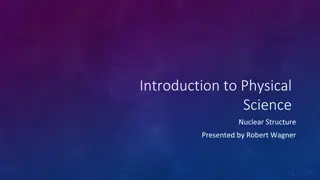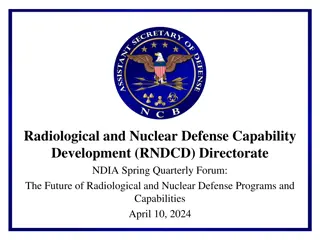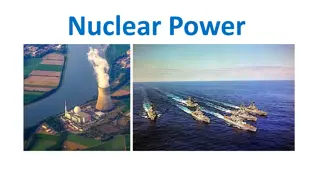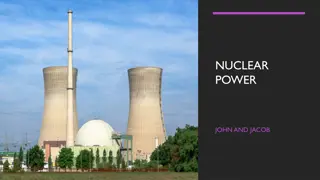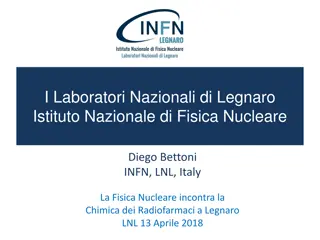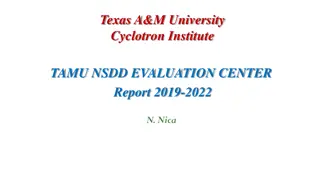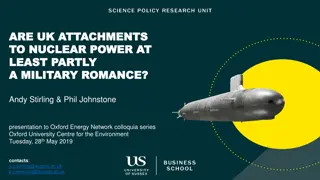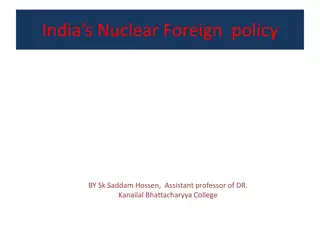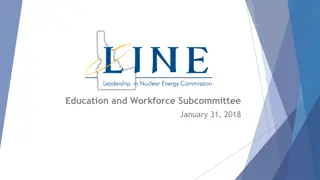Innovative Technologies for Nuclear Power Development Until 2050
The National Research Centre Kurchatov Institute is exploring fusion-fission hybrid systems and molten salt technologies for large-scale nuclear energy. Global energy consumption scenarios project an increase in needs from 10 GTFOE in 2000 to 15-35 GTFOE by 2050 and 20-50 GTFOE by 2100. Challenges include ensuring safety, maximizing fuel energy potential, and managing nuclear waste. Necessary innovative technologies, such as hybrid systems, are vital for nuclear power development. Scenarios for nuclear power industry development in Russia are based on various fuel resources like oil, coal, and uranium.
Download Presentation

Please find below an Image/Link to download the presentation.
The content on the website is provided AS IS for your information and personal use only. It may not be sold, licensed, or shared on other websites without obtaining consent from the author.If you encounter any issues during the download, it is possible that the publisher has removed the file from their server.
You are allowed to download the files provided on this website for personal or commercial use, subject to the condition that they are used lawfully. All files are the property of their respective owners.
The content on the website is provided AS IS for your information and personal use only. It may not be sold, licensed, or shared on other websites without obtaining consent from the author.
E N D
Presentation Transcript
NATIONAL RESEARCH CENTRE KURCHATOV INSTITUTE Fusion-Fission Hybrid Systems and Molten Salt Technologies in Large-Scale Nuclear Energy E. Velikhov e-mail: velikhov@mac.com
Primary energy consumption scenarios in the XXI century International organizations IAEA, IAE, IPCC, IIASA have developed energy consumption scenarios in the world in the XXI century. According to the estimates, the needs should increase from 10 GTFOE (Gigatons of fuel oil equivalent) in 2000 to 15-35 GTFOE in 2050 and 20-50 GTFOE in 2100.
Global Energy Demands and Supply Opportunities of Energy Sources Balance of Primary Energy Sources 30000 25000 MTons of oil equivalent 20000 15000 10000 5000 0 1930 1950 1970 1990 2010 2030 2050 Oil Coal Biomass and Waste Nuclear Energy Gas Hydro Miscellaneous Pent-up demand
These problems are follows: Full nuclear and radioactivity environment safety, protecting from possibilities to repeat the accident as Chernobyl, Fukushima or Three Mail Island with the pollution of radioactivity in levels to threatening population and environment, as could say the Green fission energy. Maximum usage of the fuel energy potential by increasing of the burn up level of nuclear fuel and using closed fuel cycle. The utilization of nuclear waste which make easy the decision of burying of using at power station and centralized processing and transmutation minor actinides. To create the harmonized structure of nuclear energy from extraction of raw materials and using it in all type of fission reactors, including hybrid devices as green nuclear energy to minimize nuclear waste during process of preparation fuel, to utilization long term nuclear waste.
Necessary innovative technologies for nuclear power development until 2050 Hybrid systems The development of nuclear power industry in accordance with social requirements is possible only on the innovative technologies basis. IAEA Nuclear Energy Series No NP-T-1.8 Nuclear Energy Development in 21-st Century: Global scenarios and regional trends. 2010,Vienna, Austria.
The scenarios of innovative development of nuclear power industry in Russia are based on the all kind Russian fuel resource Oil Lithium-6 Other Coal Uranium-238 Thorium-232 Uranium-235 Oil 12 109 t, Gas - 44 1012 m3, Coal - 1.57 1011 t, Unat 6 105 t Main energy sources are U238, Li and Th232
Fusion Fission Hybrid Systems are considered in world Fusion and Fission communities (meetings in USA, Russia, China, India; conferences of IAEA, APS, APS) Igor Kurchatov had pointed out on the possibility to use fusion neutrons of nuclear fuel breeding (Pu, U233, T) in his historic letter to the USSR Government in January 1951 Hybrid systems for nuclear fuel breeding and incineration of long life isotopes have been intensively discussed in USA and USSR in during 70-ies of XX century. Results have been summaries in proceedings of the joint seminar at Kurchatov Institute, Moscow in 1976
First Russian design of a hybrid reactor under E. Velikhov and I. Golovin leadership was developed in 1977 Hybrid tokamak design parameters a=1.5 m, R=6.4 m, K=2, Ip=3.8 MA, Bt=6 T, PNBI=200x8=1600 MW, ENB=500 keV Pfus 600 MW Hybid S=633m2, V=575m3 U238=54,2 Li2 Al2O4 = 59,4 H2O=49,3 Plasma Li2Al2O4 Blanket schematic diagram Dimensions are in cm The shield width is 70 cm
Nuclear design parameters of the Hybrid reactor (1977) Average thermal power, MW 6905 Electric power, MW 2500 Blanket charge of U-238, ton 1110 Irradiation time interval, year 2.65 Plutonium breeding rate, kg/y 4200 Build-up of Pu in Uranium by the end of the campaign, kg/ton 10 Tritium consumption, kg/y 37.2 Tritium breeding in blanket kg/y 38.7 Lithium mass, ton 160 Blanket area, m2 545 Lithium containing blanket area, m2 41 Thickness of blanket and shield, m 1.4 Tritium breading ratio 1.04
Opportunities of Hybrid Systems are considered in Russia in the following aspects: technologies of continuous processing the fission products. This approach simultaneously escapes heavy reactivity accidents and accidents with loss of heat transfer -breeding of U233 from Thorium in a molten salt blanket with fission with low radioactivity -development of Green Nuclear Power on the basis of molten salt fuels and suppressed salt technologies U fuel cycle technologies and materials needed for DEMO project -Minor Actinides transmutation and auxiliary electricity generation using molten -High temperature energy generation in subcritical active core with Th- development and testing plasmophysical, electrophysical, nuclear
Hybrids (FNS) IAEA Nuclear Energy Series No NP-T-1.8 Nuclear Energy Development in 21-st Century: Global scenarios and regional trends. 2010,Vienna, Austria.
Important consequence of hybrid technologies implementation should become a substantial reduction of radiotoxicity generated in nuclear fuel cycle and the contamination level produced by the fuel processing This problem becomes most significant if a closed nuclear fuel cycle will be adopted These crucial issues of hybrid systems and technologies laid in the project of the Pilot Hybrid Plant that is aimed at construction of the device by 2030
Strategy 2013 for Fusion-Fission development in Russia Burning Plasma Physics T-15 ITER DEMO PROTO Nuclear physics and technology DEMO-FNS PHP Test beds for enabling technologies Hybrid Fusion Test beds for molten salt technologies Nuclear technologies of new generation 2030 2050 2015
Tokamak will be the fusion part of Hybrid reactor TOKAMAKS: Have a possibility to create steady state neutron sources with the yield of 1016-1020 n/s have a high potential for development while other competitors are close to technical limits have already demonstrated the seconds of generation 5 1018 n/s with neutron energy 14.1 MeV in DT reaction and 5 1016 n/s with neutron energy 2.5 MeV in DD reaction
Milestones of Hybrid Program Design and upgrade of T-15 tokamak and other RF test beds and facilities as physical prototypes of Fusion Neutron Source FNS Development of DEMO-FNS and design of Pilot Hybrid Plant (PHP) for transmutations, tritium and fissile isotopes breeding Design, construction and transfer of Hybrid Reactors for fuel breeding and transmutations and Fusion Neutron Sources for research and innovative neutron technologies to Nuclear Industry, Science and Technology
Concept of tokamak based Fusion Neuron Source Aspect ratio about Moderate size and elongation Fusion/Heating power amplification factor D-T fusion power H-factor in ITER scaling for energy confinement Neutral beam energy Inductive and non-inductive of current ramp-up and current drive Kinetic control in steady state operation mode 2.5 Q ~1 1,2-1.4 < 500 < 100 MW
Feasibility of Pilot Hybrid Reactor by 2030 1. Regimes with Q~1 are realized in tokamaks 2. Electron temperature sufficient for DT beam driven fusion T = ~4 keV has been demonstrated in numerous experiments 3. Non-inductive current drive has been demonstrated in conventional tokamaks 4. Reduction of techical requirements on neutron loading in PHP to 0.2 MW/m2 and fluence value for operation time below 2 MWa/m2 allows to use commercially available materials 5. Economics of PHP is acceptable in case of total products sale : MA incineration, electricity production, tritium, fuel breeding for U-Pu and Th-U nuclear fuel cycles. 6. Russia has an appropriate cooperation of fusion and fission organizations and well qualified staff 7. System models and codes predict appropriate parameters of PHP 8. Structural materials developed for nuclear reactors are available with appropriate lifetime in neutron environment and property recycling after irradiation
Major facilities on the path to Industrial Hybrid Plant DEMO-FNS as test bed for fusion and fission technologies DT neutrons Russian Tokamaks Technology Test beds MS blankets Steady State Technologies 1. Magnetic system 2. Vacuum chamber 3. Divertor 4. Blanket 5. Remote handling 6. Heating and current drive 7. Fuelling and pumping 8. Diadnostics 9. Safety 10.Molten salts 1.Integration 1.Materials 1.Components 2.Licensing 1.Hybrid Technologies Pilot Hybrid Plant construction by 2030 P=500 MWt, Qeng ~1 Industrial Hybrid Plant construction by 2040 P=3 GWt, Qeng ~6.5, P=1.3 GWe, P=1.1 GW(net), MA=1t/a, FN=1.1 t/a
Pilot Hybrid Plant (2030) CryostatPoloidal coils Vacuum vessel Central solenoid R, 2.5 R/a 2.5 2.1 0.5 Blanket Ip, MA 5.0 BT, T n, 1020m-3 5.0 NBI port 1.0 18.4 m Pntn/S, MW/m2 0.2 Eb, keV 500 Toroidal coils Pb, MW 30 Angle of NBI, degree 0 PEC, MW 6 H-factor 1.2 N <3 Coolant piping fnon-ind 1.0 18.2 m Pdiss, TF, MW 15.0 Supporting structure Pdiss, PF, MW Swall, m2 5.0 160 Vpl, m3 50 Fissile isotope and tritium breeding, incineration of long life radiotoxicity, electricity production, molten salt technologies for nuclear fuel cycle
Schematic diagrams of hybrid blankets 140 10 bar water 20 Heat transfer Storage Secondary loop Hear exchanger, secondary loop Molten salt 92% NaBF4+8% NaF 539 480 1.7 kg/s Hear exchanger, primary loop Molten salt 85% FLiNaK+15% ThF4580 5.86 kg/s Cooler 550 1 bar Primary loop Molten salt blanket module Thermal power 175 kW Drain vessel
The conception of the radioactivity reduction during process production fuel from raw isotopes by the capture of fusion neutrons of U238 and Th232 in molten salt blanket located around tokamak. The construction of molten salt circuit channel allows continuously remove from neutron flux Pu239 and U233 together with small number of fission products. In comparison with fission breeder the fuel production in hybrid number fissions very minimized will this provides the radioactivity reduction losses more than order. Also the energy output will reduce by order during of the fuel production.
Neutron generation and Energy balance for new fissile isotopes production for Hybrid and fast breeder Pu239 from U-238 U-233 from Th-232 Capture Fission Capture Fission 3.35 0.6467 1.73 0.14 Energy released per one fissile isotope 43 MeV 25 MeV In fast reactor for produce one fissile isotope > 500 MeW energy is released
Fuel cycle with low radioactivity FNS Pa Pa U - 233 n + Th Pa n+Th TR T Th-232 Reprocesing Th- fuel Back End Fission fuel with fission products 27
Reduction of the radioactivity for nuclear fuel cycle loss Hybrid reactors with a molten salt blanket resolve the actual task of reducing the impact of Nuclear Energy fuel cycle on environment Modeling shows that fission rate in hybrid blanket for fuel isotope breeding is substantially less than in fast reactors, which reduces the activity of processing loss more than an order of magnitude Growth of activity for 0.1% loss 1 fast reactor with breeding factor ~ 1 2 fast reactor with breeding factor ~ 1.4 3 hybrid reactor 4 modern fission power plants with VVER
SCHEME OF STRUCTURE AND PROPERTIES RESTORATION OF BLANKET MATERIALS IN HYBRIDS USING RECOVERY ANNEALING 1. 2. 3. 4. Th232 U238 5. 6. 7. 8. , irradiation re-irradiation The technology developed of recovery annealing, that restores the properties of blanket structural materials, allows us to make the hybrid reactor life time higher
Recovery annealing of materials for lifetime extension of nuclear facilities The use of annealing the reactor pressure vessel (RPV) made of heat-resistant steels leads to the restoration of mechanical properties to initial values due to recovery of the structural state and dissolution of grain boundary segregation of impurities formed under irradiation. Recovery annealing was performed for 15 VVER-440 RPV that provided their lifetime extension for another resource. 0 30 years Lifetime >60 years Now the regime and technology of recovery annealing are developed for VVER-1000 RPV. It doubles the lifetime of operating VVER-1000 reactors and avoids commissioning of additional units. A similar approach can be used to extend the lifetime of VVER-1000 internals made of stainless steel and can also be considered for blanket materials of future fusion facilities
Conclusions Fusion-Fission Hybrids based on tokamak concept and molten salt nuclear technologies open new opportunities for Nuclear Energy in 21-st century to resolve challenges of controlled fusion, limited resources of fissile isotopes and radiotoxicity generation Physics and engineering data bases on fusion and fission technologies, structural and functional materials are sufficient for design of demonstration hybrid facilities Reseach and Development Program aimed at creation of demonstration hybrid facility DEMO-FNS and pilot hybrid plant PHP has been proposed in Russia The Pilot Hybrid Reactor project together with ITER project are capable to become basis for construction of the first Commercial Fusion Power Plant (CFPP) in Russia by 2050



